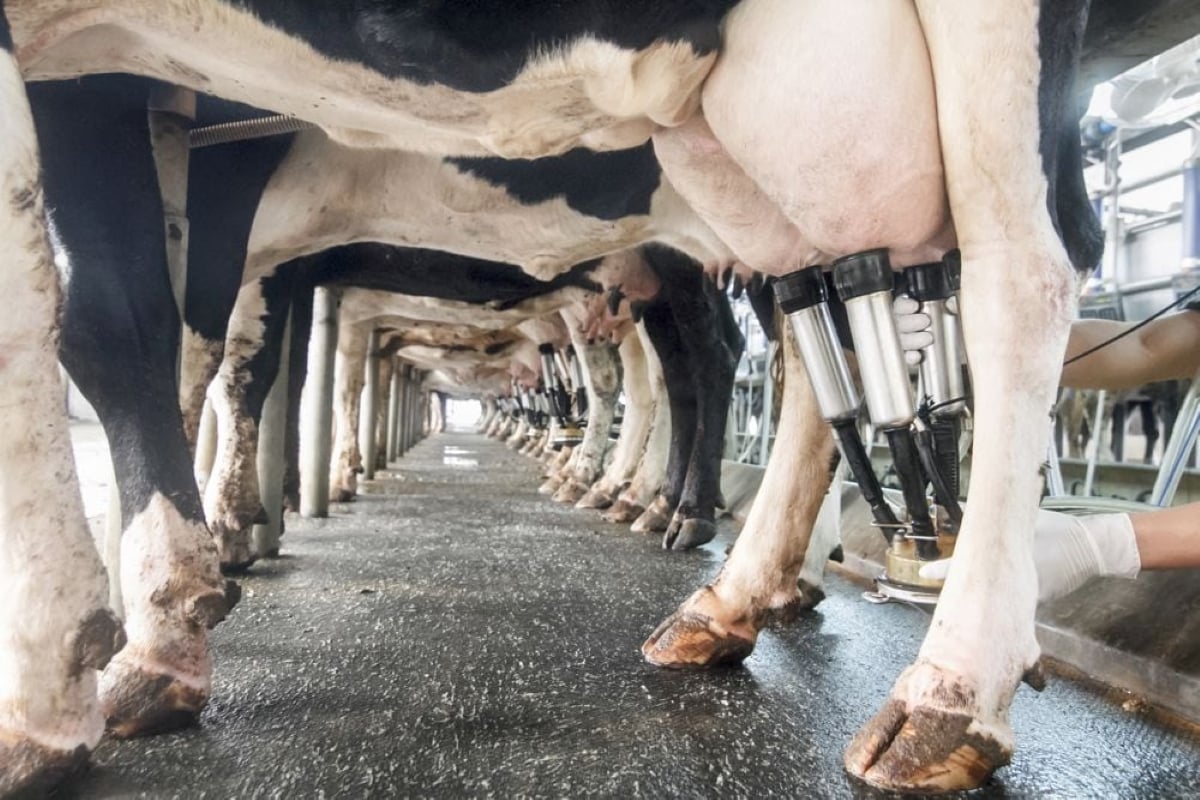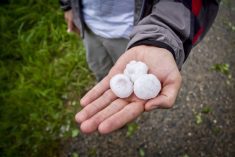OAKLAND, Man. — As water rushed under a bridge about four kilometres south of Lake Manitoba, it was hard not to think of the Nile, Amazon or one of the world’s great rivers.
In mid-July, approximately 35,000 cubic feet per second of water was flowing through the Portage Diversion, which transports water from the Assiniboine River to Lake Manitoba near Portage la Prairie, Man.
Water in the drainage channel stretched at least 500 metres from bank to bank as excavators and other heavy equipment moved earth to stabilize the diversion and contain the powerful flow.
Read Also

Farm gate milk price to rise in 2026
The Canadian Dairy Commission will raise its farm gate milk price by 2.3255 per cent in February, the Crown corporation announced on Friday.
The water was nearly at the top of the banks and if the water was only a few centimetres higher, it would have flowed onto corn fields and other crops on the east and west sides of the channel.
Two km north of the bridge about 150 farmers, cottage owners and municipal representatives from around Lake Manitoba met at a farm adjacent to the drainage channel July 15 to express their frustration over the massive amount of water entering the lake.
In 2011, Lake Manitoba rose to record heights, flooding out pasture, hayland and cottage property around the lake.
Landowners said at the time and still maintain that 2011 was an artificial and deliberate flood because the province diverted excess water from the Assiniboine River into Lake Manitoba to protect property east of Portage la Prairie.
Following 150 to 200 millimetres of rain in eastern Saskatchewan and western Manitoba in late June, Lake Manitoba farmers are now worried about a repeat of 2011.
Rural Municipality of Portage La Prairie reeve Kam Blight, who spoke at the meeting, said landowners around the lake are sick and tired of being a dumping ground for western Canadian water.
“Right now, Saskatchewan, I promise you this, is scurrying to get as much drainage as they possibly can done because they don’t want a repeat of the flood that just happened,” he said. “That means all that water (will be) coming this way. If the federal government and the province can’t step in and get something happening with Saskatchewan, then they better invest a pile of money in this area to make damn sure that everyone here is protected and can enjoy a proper livelihood…. We cannot be sitting ducks here, waiting for this to happen all over again.”
In an interview following his presentation, Blight said drainage in Saskatchewan is only a piece of the story.
“They’re not the only problem, by any stretch of the imagination,” he said. “But with their water coming to us so much faster and with such high volumes, we have a hard time managing our own and then all of sudden their (water) is on top of us…. All of that water funnels right to this area.”
The Manitoba government has promised to construct a drainage channel at the north end of Lake Manitoba to move excess water into Lake Winnipeg and this spring the province introduced a comprehensive water management strategy.
Blight said that’s great, but so far the promises are simply rhetoric.
“That’s all talk, though. There’s been no action,” he said as other speakers at the meeting took their turn at the microphone. “Yes, there is a new flood mitigation strategy in place. But we need buy- in from people and that’s going to take a while. And we also need buy-in from our neighbours to the west.”
Steve Ashton, Manitoba infrastructure and transportation minister, said it could take up to seven years to construct the new drainage channel at the north end of the lake.
Nearly every speaker at the meeting, which was held at Mark Peters’ farm, said a seven-year timeline is unacceptable.
“We need flood mitigation, flood solutions from Lake Manitoba immediately. Not seven years, not three, not two, now,” said Tom Teichroeb, a rancher from Langruth, Man., and chair of the Lake Manitoba Flood Rehabilitation Committee.
Teichroeb said the province should declare a state of emergency regarding rising lake levels, which would empower the government to begin digging the Lake Manitoba-Lake Winnipeg channel immediately.
During his presentation, Teichroeb read an email from Bob Sopuck, MP for Dauphin-Swan River-Marquette, to clarify the federal government’s position on the drainage channel.
In the email, Sopuck said federal regulations are not responsible for the seven-year construction timeline because he helped amend and revise the fisheries act, the Canadian environmental assessment act and the navigable water protections act. Those changes made the regulations less cumbersome, not more so.
“The government of Manitoba has made the preposterous statement that the new outlet cannot be built for seven years due to the regulatory process, amongst other things,” he said.
“If they are referring to the federal process, that is complete nonsense…. For the (Manitoba) government to suggest this is a blatant and I would say deliberate misinterpretation of the situation.”
Blight said he doesn’t know how long it takes to build a channel between Lake Manitoba and Lake Winnipeg, but the province needs to act now.
“They should start turning soil immediately,” he said. “If there’s no sense of urgency because of this event right now, I don’t know what will bring a sense of urgency.”














